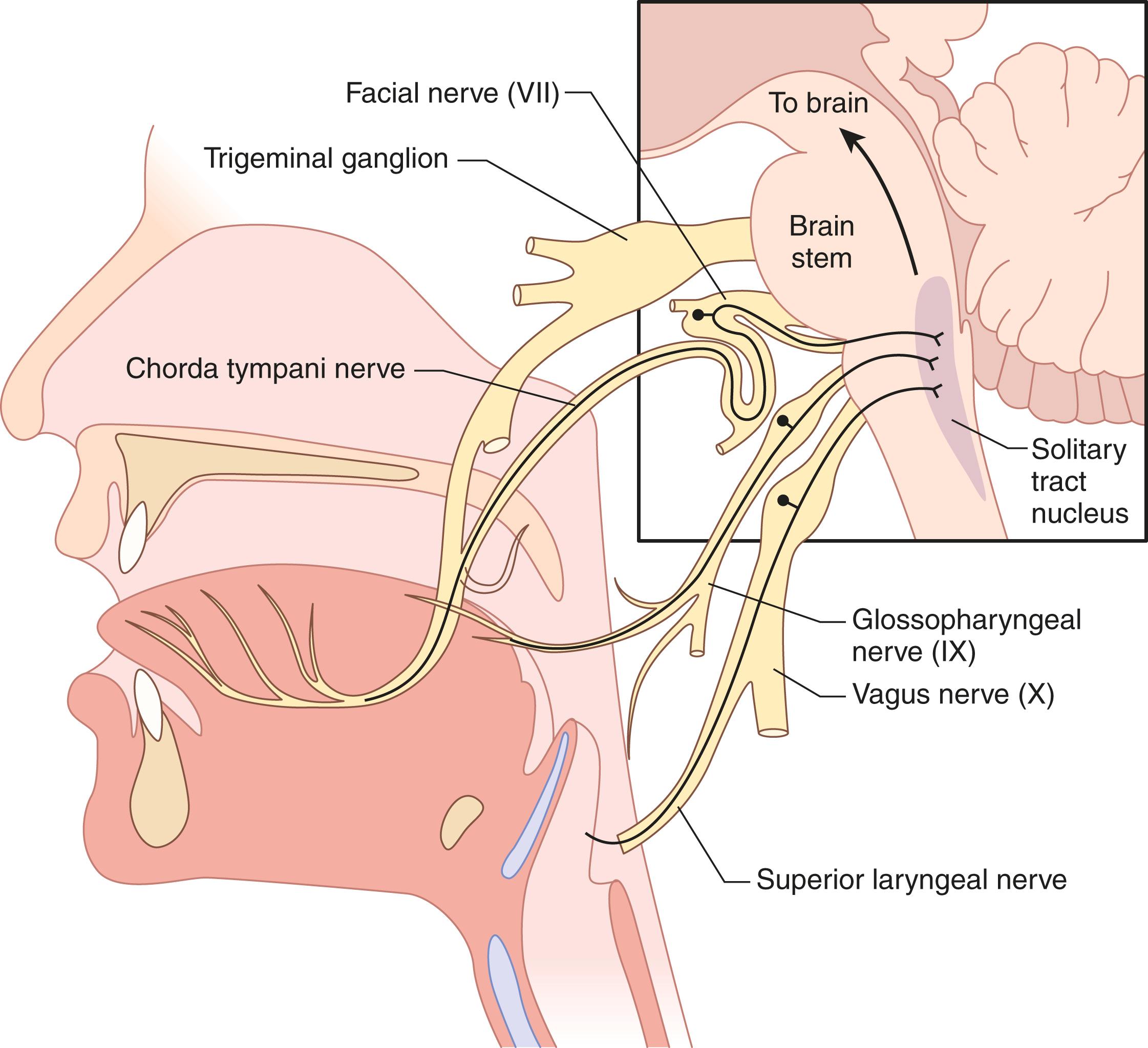Physical Address
304 North Cardinal St.
Dorchester Center, MA 02124
Loss of smell is increasingly being recognized by the fifth decade of life, and an inability to smell or a diminished sense of smell is present in 3 to 20% of the population. Nevertheless, these disorders are often neglected because they are not fatal and, unlike abnormalities of vision and hearing, are not considered serious handicaps. Recently, however, loss of taste and smell has been identified as a common and very bothersome symptom in patients with coronavirus disease 2019 (COVID-19; Chapters 335 to 337 ), in which changes in smell occur in up to 50% of cases, , usually several days after the onset of other symptoms, and taste papillae may be dysfunctional for 6 months or more.
The sensory receptor for taste, the taste bud, is made up of 50 to 150 cells arranged to form a pear-shaped organ. The lifespan of these cells is 10 to 14 days, and they are constantly being renewed from dividing epithelial cells surrounding the bud. Taste buds are located on the tongue, soft palate, pharynx, larynx, epiglottis, uvula, and upper third of the esophagus. The taste buds located on the anterior two thirds of the tongue and on the palate are innervated by the chorda tympani branch of the seventh cranial nerve. The ninth cranial nerve innervates the posterior third of the tongue. The ninth and tenth nerves innervate taste buds in the pharynx and larynx. Afferent signals from the taste buds project to the nucleus of the solitary tract in the medulla and then through a series of relays to the thalamus and postcentral somatosensory cerebral cortex (primary ipsilateral). Free nerve endings of the fifth cranial nerve are found on the tongue and in the oral cavity, and lesions involving these pathways can also alter taste perception.
Olfactory receptors lie in a roughly dime-sized area of specialized pigmented epithelium that arches along the superior aspect of each side of the nasal mucosa. Specialized bipolar sensory cells in this region thrust short receptor hairs into the overlying mucosa to detect aromatic molecules as they dissolve. Like taste buds, the specialized receptor portion of the bipolar neuron undergoes continuous renewal, with turnover occurring approximately every 30 days. Thin axons of the bipolar neurons course through small holes in the cribriform plate of the ethmoid bone to form connections in the overlying olfactory bulb on the ventral surface of the frontal lobe. From there, second- and third-order neurons project directly and indirectly to the prepiriform cortex and parts of the amygdaloid complex of both sides of the brain, which represents the primary olfactory cortex.
Genes that encode chemoreceptor proteins belong to the G protein–coupled receptor superfamily, which accounts for up to 1% of mammalian genomes. Sequence diversity in these genes encodes unique structural motifs that bind to different ligands signaling different odors and tastes. Distinct and dedicated taste receptor cells express unique receptors to detect each of the five basic tastes: sweet (sensed by the heterodimers T1R1 and T1R3), umami (detected by the heterodimers T1R2 and T1R3), bitter (sensed by an estimated 30 T2Rs), sour (sensed by PKD2L1, with membrane-tethered carbonic anhydrase IV sensing carbonation), and salty (epithelial sodium channel). The taste receptor cells transform and transmit information to primary afferents through multiple cranial nerves (VII, IX, and X) that project to the solitary tract nucleus in the brain stem, with relay in the thalamus, and then onward to the primary cortex ( Fig. 395-1 ).

Disorders of taste and smell can be divided into local, systemic, and neurologic categories ( Table 395-1 ). The taste buds and the specialized receptor portion of the bipolar olfactory cells are constantly being renewed, and the process of renewal can be affected by nutritional, metabolic, and hormonal states as well as by therapeutic radiation, drugs, and age. For example, with interruption of mitosis by antiproliferative agents, return of normal taste function takes a minimum of 10 days, whereas return to normal olfactory function takes more than 30 days. The most implicated drugs are taxanes, capecitabine, cyclophosphamide, epirubicin, the anthracyclines, and 5-fluorouracil analogues. Diuretics can block apical ion channels on a taste bud, and antifungal drugs inhibit cytochrome P-450–dependent enzymes at the level of the receptors. Numerous local conditions, such as colds and allergies, chronic sinusitis, and nasal polyposis, can influence the sense of smell by restricting airway patency. Accidental blows to the head can shear the fine axons of the bipolar olfactory neurons and result in loss of smell. Lesions of the fifth, seventh (chorda tympani), and ninth nerves can lead to disordered taste sensation. Kallmann syndrome ( Chapter 216 ) is anosmia associated with male infertility owing to defects in the secretion or action of gonadotropin-releasing hormone. By comparison, the loss of smell and taste in COVID-19 appears to be centrally mediated via immune inflammation.
| TASTE | SMELL | |
|---|---|---|
| Local | Radiation therapy, oral infections, dentures, dental procedures | Allergic rhinitis, sinusitis, nasal polyposis, upper respiratory infection |
| Systemic | Cancer, renal failure, hepatic failure, nutritional deficiency (vitamin B 3 , zinc), Cushing syndrome, hypothyroidism, diabetes mellitus, infection (viral), drugs (antirheumatic and antiproliferative, e.g., corticosteroids, cisplatin, carboplatin, cyclophosphamide, doxorubicin, and methotrexate) | Renal failure, hepatic failure, nutritional deficiency (vitamin B 12 ), Cushing syndrome, hypothyroidism, diabetes mellitus, infection (viral hepatitis, influenza), drugs (nasal sprays, antihistamines, decongestants, antibiotics, and antirheumatic and antiproliferative drugs that affect taste) |
| Neurologic | Bell palsy, familial dysautonomia, multiple sclerosis | Head trauma, multiple sclerosis, Parkinson disease, Alzheimer disease, frontal tumor |
Become a Clinical Tree membership for Full access and enjoy Unlimited articles
If you are a member. Log in here